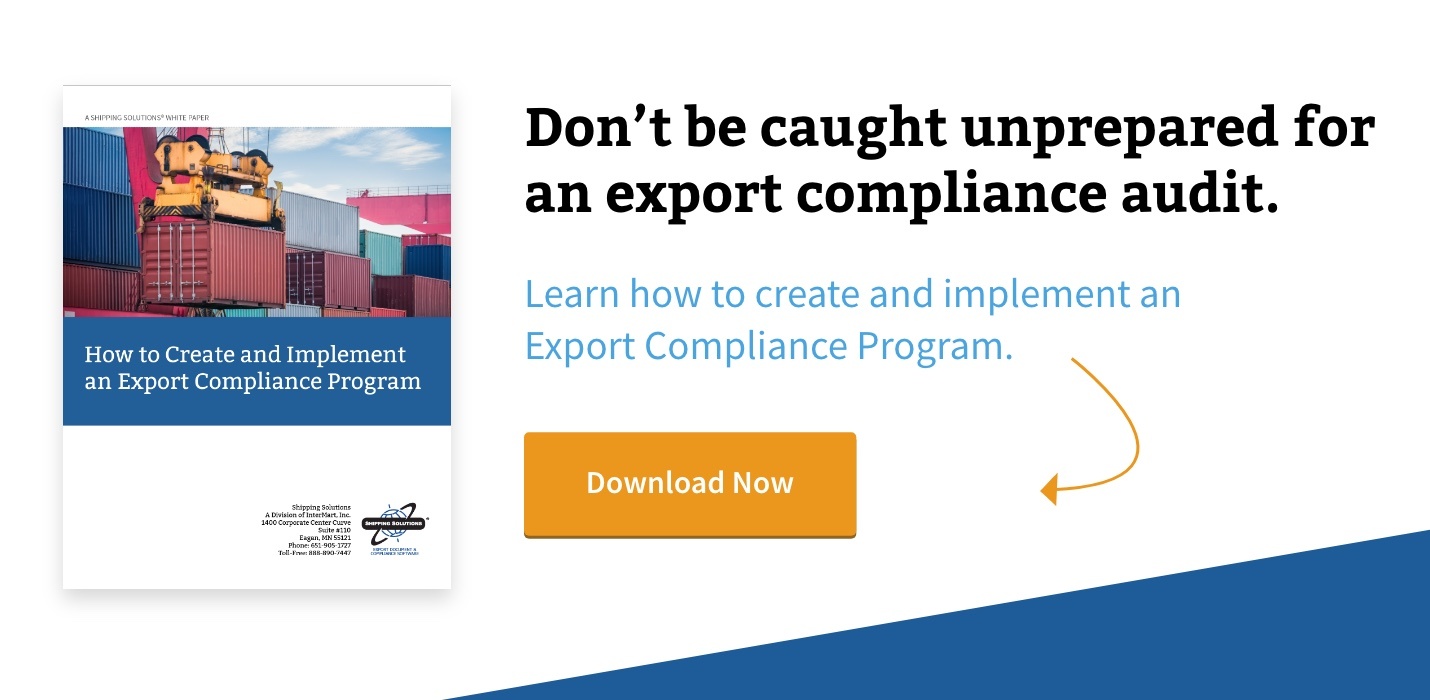Shipping Easy How to Export Shipment History
When I first talk to exporters frustrated by the amount of time it takes to complete their export documentation, they often tell me they can spend two hours or more on every single shipment. If they have multiple export orders to ship, the time they have left to do any other part of their job is virtually nil. A typical export shipment can require five or more documents including a commercial invoice, a packing list, a shipper's letter of instruction, a bill of lading, and a certificate of origin. On top of that, a shipment valued at more than $2,500 per Schedule B code needs to be filed electronically through the Automated Export System (AES). And, of course, every shipment, regardless of value, needs to be screened against U.S. export regulations. It's easy to see why it can take so long! To help companies save time creating their export documents, I've come up with five tips for addressing your export documentation process: If you were about to begin a home project, whether it be building a set of bookshelves or cooking a five-course dinner, you'd start by laying out all your tools and ingredients. The same goes for beginning an export documentation project. Make sure you have all the paperwork and information you need before you begin. Do you have complete descriptions including weights and dimensions of the products you're shipping? Do you have an idea of the forms you'll need to complete and send with the shipment? If you don't have the export forms available, do you know where you can quickly find them? Airline pilots use checklists when taking off and landing aircraft. It's easy to understand why. The procedures and processes are too many and too complex to memorize, and just one overlooked detail could jeopardize the safety of the flight. Exporting also has its share of complexity, where one overlooked detail could delay your shipment or derail it in customs for days or weeks. Instead, create an export documentation checklist with check boxes for each step in the process. List every item in the order it must be completed. A simple checklist almost guarantees you won't forget a step while you're processing a shipment. It can also prove an invaluable tool if you ever get audited by the Office of Export Enforcement or any other agency that has jurisdiction over exports. Finally, it's easy to create your checklist as a Word or Excel document. Add numbers and empty check boxes next to each item. Checklists can also be created using Google Docs and easily shared with employees throughout your company. Accuracy is critical when preparing export documents, so make sure you include a step on your checklist to proof your work and all forms before you ship anything. Exporting is a complex topic. The more you know about export, the easier and more familiar the subject will become. Export knowledge gives you the proper context to understand the why and the how behind each export form and the other shipping requirements. The more you know, the more you can anticipate what's required as you're preparing forms. That just makes things go a lot faster! The good news is you don't have to go back to school to acquire the knowledge that will give you a leg up. Start by reading these blog posts on the Shipping Solutions website: In addition to these articles, check out the following government websites for export-related information and insights: Finally, there are a variety of books, seminars and webinars on the topic: Many exporters use templates created in Word, Excel or Google Docs for preparing their paperwork. Templates are more efficient than completing paper documents and can be customized with your company's corporate identity. Templates work particularly well when you have a limited set of customers you ship to or a limited number of products you export. In this case, you can often just copy a previous set of documents you've created and update only the information that has changed from one shipment to the next. Just make sure you double check your work to ensure none of the old information remains on the form. Templates also save you money over buying and stocking pre-printed forms, although there is a cost associated with the time it takes to create the templates. If your company does create is own templates, it's important to monitor changes to export regulations and shipping requirements to ensure the templates remain compliant. The downside of using templates for your export paperwork is that you still usually need to enter your shipping information on multiple forms, since they aren't linked together. In addition, you have to reenter all your export information again when filing your electronic export information (EEI) through AESDirect and screening the parties in your shipment against the government's denied party lists. The fastest way I know to create your export documents is to use a software program like Shipping Solutions. Shipping Solutions users tell us the software allows them to create their export forms up to five-times faster than using templates or paper documents. For example: With Shipping Solutions, you only need to enter your export information once, and the software automatically populates the data fields on more than two dozen export documents. You can store your contact, product and company information in the various Shipping Solutions databases to eliminate redundant data entry. Shipping Solutions Professional also allows you to import orders from your accounting or ERP system to save even more time. In addition to saving time, importing your orders or utilizing the software's various databases helps improve the accuracy of your documents by minimizing the chances of a typographical error that could slow your shipments or delay payments for your exports. When it comes time to file through AES, you can simply click a button in the software and the program uploads the data to AESDirect. You don't have to reenter the information on a website or pay a third-party do it for you. Finally, the software saves you more time (and possibly a lot of money) when it makes it easy to check your shipments against all the government denied party lists, Export Administration Regulations, and International Traffic in Arms Regulations. Regardless of how you create your export forms, your responsibilities don't end when your shipment leaves the dock. The next steps aren't often discussed, but they are critical to making sure you're following the legal requirements for export documentation. Here are five tips for organizing your export paperwork: The most important thing exporters can do post-shipment is to keep a thorough paper trail of all exports. As a general rule, export regulations require you to maintain export documentation for at least five years after an export transaction is complete. For most companies, this means five-plus years' worth of paper records. This includes: As a rule, paper copies work better than electronic. All handwritten notations must be saved and stored with corresponding files. We recommend printing hard copies of every file, note and document associated with your shipments, but if you can't, you must at least scan in your paperwork and keep an electronic file. A thorough archive of your export documentation won't do you any good if it's located in a storage unit 500 miles away and an auditor or regulator comes to your office and demands to see your files on the spot. Make it an urgent and important task at your next meeting to discuss with your colleagues both how you're going to store your export documentation and where it will be kept in your office. Keep in mind that your records need to be secure, easily accessible, and at least three people within your company need to be able to find them in a moment's notice (should the Office of Export Enforcement come knocking on your door, at least you won't have to worry about where to find your documents). One key practice that can keep your company on the safe side of export compliance is to understand clearly what communication your sales team has with foreign entities and government officials. The Foreign Corrupt Practices Act (FCPA) prohibits bribes to foreign officials to assist in obtaining or retaining business. According to the U.S. Securities and Exchange (SEC) website: The FCPA can apply to prohibited conduct anywhere in the world and extends to publicly traded companies and their officers, directors, employees, stockholders, and agents. Agents can include third party agents, consultants, distributors, joint-venture partners, and others. The FCPA also requires issuers to maintain accurate books and records and have a system of internal controls sufficient to, among other things, provide reasonable assurances that transactions are executed and assets are accessed and accounted for in accordance with management's authorization. By managing what your sales team is saying to foreign customers or potential customers, you can make sure your entire organization doesn't face legal action. A Resource Guide to the U.S. Foreign Corrupt Practices Act provides more information about how your company can successfully comply with FCPA. Whose job is it to organize your export documentation, and how will it be done? The answers depend on the size of your organization as well as your current administrative organization chart, to name a few things. Here are some recommendations for identifying who should administer your export documentation organization efforts: Sometimes, the best way to see how what's working and what needs improvement within your organization is to bring in an unbiased, clear-eyed third party to do an audit. If you don't have an organization plan, a third-party auditor or consultant can help you create a streamlined set of procedures and process for storing them. If you do have a plan, an auditor can review it and make sure the processes are as they should be. They can also give you insight about issues you are missing or may not know about. A helpful auditor will also be able to provide shortcuts you don't know about; conversely, they may show you that the shortcuts your organization has enacted over time are creeping dangerously close toward non-compliance. These 10 time-savings tips can not only help you save time creating and storing your export documents, they can help your company stay compliant with export regulations. That's why documenting these steps in a written manual can help ensure that your company follows these procedures. The Bureau of Industry and Security (BIS) calls this plan an Export Compliance Program (ECP) and encourages all exporters to create such a plan and document that it's being followed for every export shipment. While there's no legal requirement to do so, having an ECP plan in place—and documenting it's being followed—is a strong mitigating factor against penalties that can approach $25,000 or more. The Shipping Solutions Professional export documentation and compliance software can help you meet your export compliance responsibilities and document that you are doing so. Download a free trial version of the software to see how. This post was originally published in April 2015 and has been updated to include current information, links and formatting. 
5 Time-Saving Tips for Creating Accurate Export Forms
1. Get Organized
2. Use a Documented Process or Checklist
 Checklists are especially handy when another employee fills in for an employee who is typically responsible for export shipments.
Checklists are especially handy when another employee fills in for an employee who is typically responsible for export shipments.3. Learn Everything You Can about Exporting
4. Use Document Templates

5. Use Shipping Solutions Export Documentation Software
Saving Your Work: Organizing Your Export Documents
6. Maintain Complete Records of Your Export Shipments
7. Keep Your Records Accessible
8. Keep Track of Your International Sales Team
9. Identify Who's In Charge of Your Export Documents
10. Audit Your Export Compliance Efforts
Creating an Export Compliance Program

stoufferalwaskess.blogspot.com
Source: https://www.shippingsolutions.com/blog/10-time-saving-tips-for-creating-and-organizing-your-export-documents
0 Response to "Shipping Easy How to Export Shipment History"
Post a Comment